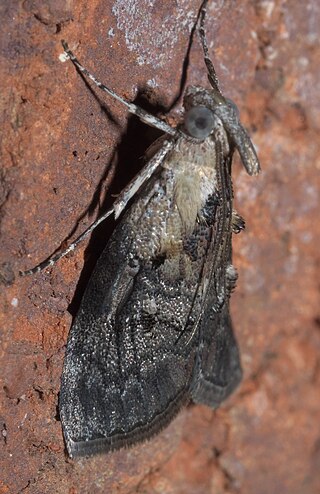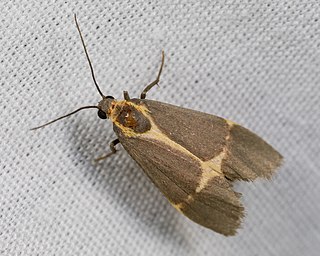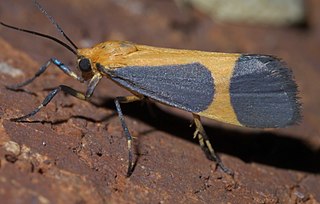
Cisthene is a genus of lichen moths in the family Erebidae. The genus was erected by Francis Walker in 1854.
Homoanarta is a genus of moths of the family Noctuidae erected by William Barnes and Foster Hendrickson Benjamin in 1923.
Phobolosia duomaculata, the double-eyed algibelle, is a moth in the family Erebidae. The species was first described by William Barnes and Foster Hendrickson Benjamin in 1925 and it is found from southern Texas, south into Mexico.

Cisthene plumbea, the lead-colored lichen moth, is a moth of the family Erebidae. The species was first described by Richard Harper Stretch in 1885. It is found in eastern North America, from southern New Jersey south to northern Florida, west to Wisconsin and Texas.

Pococera is a genus of snout moths in the subfamily Epipaschiinae, found mainly in North and Central America. It was described by Philipp Christoph Zeller in 1848.
Cacotherapia lecerfialis is a species of snout moth in the genus Cacotherapia. It was described by William Barnes and Foster Hendrickson Benjamin in 1925 and is known from the US state of California.
Aglossa gigantalis is a species of snout moth in the genus Aglossa. It was described by William Barnes and Foster Hendrickson Benjamin in 1925 and is found in North America, including the type location of Arizona.
Anemosella nevalis is a species of snout moth in the genus Anemosella. It was described by William Barnes and Foster Hendrickson Benjamin in 1925. It is found in North America, including Nevada, California and Arizona.
Cisthene coronado is a moth of the family Erebidae first described by Carroll B. Knowlton in 1967. It is found in the US state of Arizona.

Cisthene martini, or Martin's lichen moth, is a moth of the family Erebidae first described by Carroll B. Knowlton in 1967. It is found in the US states of Arizona, New Mexico and Texas.

Cisthene barnesii, or Barnes' lichen moth, is a moth of the family Erebidae. It was described by Harrison Gray Dyar Jr. in 1904. It is found in the US Rocky Mountain region, from southern Montana and western North Dakota to the border with Mexico in Arizona and New Mexico. The habitat consists of dry bunchgrass steppe.
Cisthene conjuncta, the white-streaked lichen moth, is a moth of the family Erebidae. It was described by William Barnes and James Halliday McDunnough in 1913. It is found in southern Texas.
Cisthene deserta is a moth of the family Erebidae. It was described by Felder in 1868. It is found in North America, where it has been recorded from Utah and California.

Cisthene packardii, or Packard's lichen moth, is a moth of the family Erebidae. It was described by Augustus Radcliffe Grote in 1863. It is found in the US from the states of New York to Florida and from Missouri to Texas.

Cisthene picta, the pictured lichen moth, is a moth of the family Erebidae. It was described by William Barnes and James Halliday McDunnough in 1918. It is found in the United States from Texas to Arizona. The habitat consists of deserts.
Cisthene striata, the striated lichen moth, is a moth of the family Erebidae. It was described by Rodrigues Ottolengui in 1898. It is found in the US states of Maryland, Colorado, Georgia and Florida.
Cisthene subrufa, the Tamaulipan lichen moth, is a moth of the family Erebidae. It was described by William Barnes and James Halliday McDunnough in 1913. It is found in the United States in Arizona and from San Benito, Texas south to Veracruz in Mexico.

Cisthene tenuifascia, the thin-banded lichen moth or three-banded lichen moth, is a moth of the family Erebidae. It was described by Leon F. Harvey in 1875. It is found in Mexico and from Arizona to Florida, North Carolina and Oklahoma. Strays can be found further north.
Apilocrocis pimalis, or the Pima apilocrocis moth, is a moth in the family Crambidae. It was first described by William Barnes and Foster Hendrickson Benjamin in 1926.








